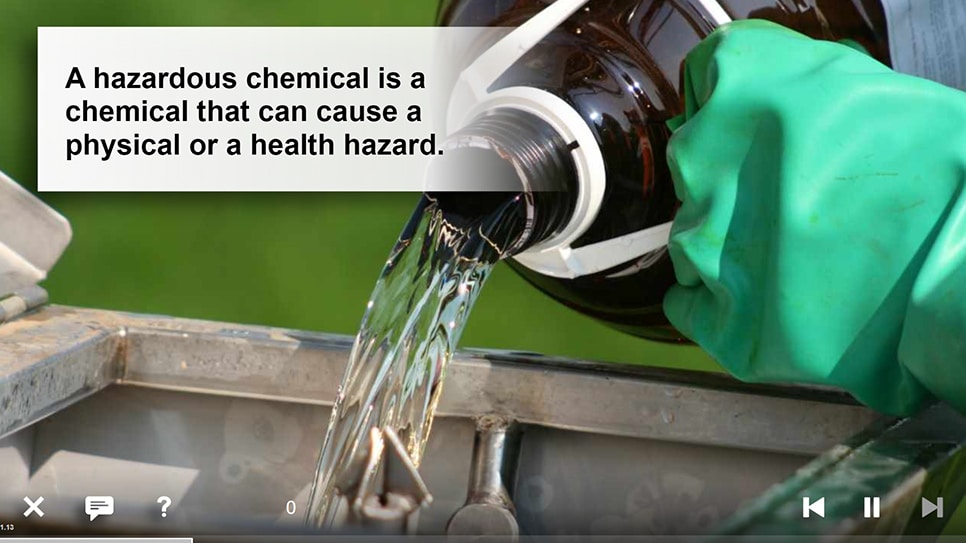
Hazard Communication Training for Employees and Businesses
Hazard communication enables employers to address OSHA requirements, safeguard the environment and keep workers safe when working around chemical hazards.
Course description
Traliant’s Hazards Communication training is a 30-minute course that covers what hazardous chemicals are and how to understand and use critical information in Safety Data Sheets, pictograms and chemical labeling to keep workers and the people who work around them safe.
The Occupational Safety and Health Administration (OSHA) Hazard Communication Standard requires employers to provide training to all employees who work near, around and with chemicals. By providing Traliant’s Hazard Communication training in conjunction with chemical hazard specific training, organizations can support their employees, keep them safe and comply with OSHA regulations.
ONLINE TRAINING
Hazard Communication Training for Employees and Businesses

Hazard Communication covers these topics and more:
- The importance of HazCom programs
- Information about hazardous chemicals in the workplace
- Purpose of Safety Data Sheets and the information they include
- Understanding labels on chemicals
- Nine common pictograms used across workplaces and industries
KEY FEATURES
Why you'll love our training
It’s time to embrace a new era of online training with a valued partner who will ensure seamless implementation, along with a learning experience your employees will truly enjoy.
Course administration
Traliant makes it simple to roll out training to your workplace and provide technical support directly to your employees at no additional cost.
Course customizations
Tailor courses to include your logo, relevant policies, workplace images, and more. Traliant can even customize the course with scenarios that take place in your own workplace environment.
Translations
Training is available in English, Spanish and is supported in over 100 languages.
What to consider when choosing the most effective hazard communication training

- Protect employee health and safety: Hazardous chemicals can pose a wide range of risks to employees, including burns, respiratory problems, skin irritation, and long-term health issues. Training helps to ensure that employees understand the hazards and how to protect themselves.
- Comply with OSHA regulations: The Occupational Safety and Health Administration (OSHA) has a Hazard Communication Standard that requires employers to provide training to employees who work with hazardous chemicals.
- Reduce the risk of accidents and injuries: Training helps to prevent accidents and injuries by teaching employees how to handle, store, and dispose of hazardous chemicals safely.
- Empower employees: Training provides employees with the knowledge and skills they need to understand the risks associated with hazardous chemicals and to make informed decisions about their safety.
- Strengthen your organization's commitment to safety: Training demonstrates the company's commitment to providing a safe working environment and to protecting the health of its employees.
- Reduce the risk of OSHA violations and penalties: Training helps to ensure that organizations are complying with OSHA regulations and to minimize the risk of fines and penalties.
- The hazards of chemicals in the workplace: Employees learn how to identify hazardous chemicals and understand the potential risks they pose.
- How to read and understand Safety Data Sheets (SDSs): SDSs provide detailed information about the hazards of a particular chemical, as well as safety precautions, handling instructions, and emergency procedures.
- How to interpret chemical labels: Chemical labels provide important information about the hazards of the product and how to handle it safely.
- The use of personal protective equipment (PPE): Employees learn about the appropriate PPE to use when working with hazardous chemicals, and how to properly use, maintain, and store PPE.
- Develop a written hazard communication program: The program should outline the company's procedures for handling hazardous chemicals.
- Maintain an inventory of hazardous chemicals: The inventory should include all hazardous chemicals present in the workplace.
- Obtain Safety Data Sheets (SDSs) for all hazardous chemicals: SDSs should be readily accessible to employees.
- Label all containers of hazardous chemicals: Labels should include the identity of the chemical, appropriate hazard warnings, and the name and address of the manufacturer or importer.
- Train employees on hazard communication: Training should cover the hazards of chemicals in the workplace, how to read and understand SDSs and labels, and the proper use of PPE.











